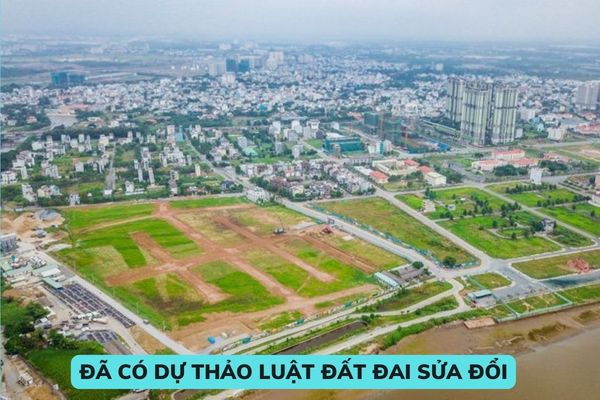What is the Draft Law on Amendments to Land Law issued by the National Assembly of Vietnam about? What is the basis for determining land types according to the Draft Law on Amendments to Land Law?
What is the Draft Law on Amendments to Land Law issued by the National Assembly of Vietnam about?
Recently, the National Assembly of Vietnam issued Draft Law on Amendments to Land Law which includes 236 Articles and XVI Chapters:
Chapter I. General Provisions
Chapter II. Rights and Responsibilities of the State and Citizens Regarding Land
Chapter III. Administrative Boundaries and Basic Land Investigation
Chapter IV. Land Use Planning and Plans
Chapter V. Land Allocation, Leasing, and Change of Land Use Purposes
Chapter VI. Land Recovery and Requisition
Chapter VII. Compensation, Support, and Resettlement When the State Recovers Land
Chapter VIII. Land Fund Development
Chapter IX. Land Registration and Issuance of Certificates of Land Use Rights and Ownership of Property Attached to Land
Chapter X. Land Finance and Land Prices
Chapter XI. Land Information System, Land Database
Chapter XII. Utilization Regimes of Various Land Types
Chapter XIII. Rights and Obligations of Land Users
Chapter XIV. Administrative Procedures Regarding Land
Chapter XV. Supervision, Inspection, Examination, Resolution of Disputes, Complaints, Denunciations, and Handling Violations of Land Law
Chapter XVI. Implementation Provisions

What is the basis for determining land types according to the Draft Law on Amendments to Land Law? (Image from the Internet)
What is the basis for determining land types according to the Draft Law on Amendments to Land Law in Vietnam?
In Article 10 of the Draft Law on Amendments to Land Law, land classification is determined as follows:
Land Classification
Based on the purpose of use, land is classified as follows:
1. Agricultural land group includes the following types of land:
a) Annual cropland includes specialized rice cultivation land, remaining rice cultivation land, and other annual crop cultivation land;
b) Perennial cropland;
c) Forestry land includes production forest land, protective forest land, and special-use forest land;
d) Concentrated livestock land;
dd) Aquaculture land;
e) Salt production land;
g) Other agricultural land includes land used for constructing greenhouses and other structures for cultivation purposes, including forms of cultivation not directly on the land; land for study, experimental research, and testing for crops, livestock, aquaculture; land for nursery gardens, breed gardens, and flower, ornamental tree cultivation; rest houses, sheds, camps for laborers in agricultural production establishments; land for constructing warehouses and storage facilities for agricultural products, pesticides, fertilizers, machinery, tools associated with agricultural production areas, and other constructions directly serving agricultural production without non-agricultural purposes.
2. Non-agricultural land group includes the following types of land:
a) Residential land includes homestead land in rural areas and urban areas;
b) Land for constructing agency offices;
c) Land used for defense and security purposes (referred to as defense land, security land);
d) Land for constructing public service facilities includes land for constructing headquarters of public service organizations; land for cultural, social, health, education and training, sports, science and technology, environmental, meteorological, hydrological, and diplomatic projects and other public service facilities;
dd) Land for non-agricultural production and business includes land for industrial parks, industrial clusters, and export processing zones; commercial land; non-agricultural production establishment land; land used for mineral activities;
e) Land used for public purposes includes land for transportation facilities (including airports, seaports, inland waterway ports, maritime ports, railways, roads, and other transportation facilities); irrigation works; natural disaster prevention and control works; land with historical-cultural relics, natural heritage sites, scenic beauty spots; community activity land, public amusement parks, and public recreation areas; energy works; postal and telecommunications works; markets; fishing ports, storm shelter areas for fishing boats, dumping grounds, waste treatment facilities, and other public works;
g) Land used for religious and belief activities (referred to as religious land, belief land);
h) Land for cemeteries, graveyards, funeral homes, crematoria, and storage of ashes;
i) Specialized water surface land;
k) Other non-agricultural land.
3. Unused land group includes land yet to be allocated or leased, including unused flat land, unused hilly land, and rocky mountains without forest cover; inland water surface; coastal water surface; rivers, streams, canals, channels, and unused springs and other types of land not yet determined for use purposes.
Based on the purpose of use, land is classified into three types: agricultural land, non-agricultural land, and unused land.
What are prohibited acts under the amended Draft Law on Amendments to Land Law in Vietnam?
In Article 12 of the Draft Law on Amendments to Land Law, the following acts are prohibited in the land sector:
- Encroaching, occupying, and destroying land.
- Non-compliance with announced land use plans and planning.
- Not putting land into use or using land for incorrect purposes.
- Not complying with the law when exercising land user rights.
- Acquiring land use rights contrary to the law.
- Using land and conducting land use right transactions without registering with government authorities.
- Not fulfilling or inadequately fulfilling financial obligations to the State.
- Violating regulations on land management and use.
- Failing to prevent or handle land law violations, resulting in serious consequences.
- Failing to provide or provide inaccurate land information as required by law.
- Obstructing or causing difficulties in exercising the rights of land users as prescribed by law.
- Discriminating gender in land management and use activities.
- Misusing the Land Development Fund for unauthorized purposes.
LawNet
